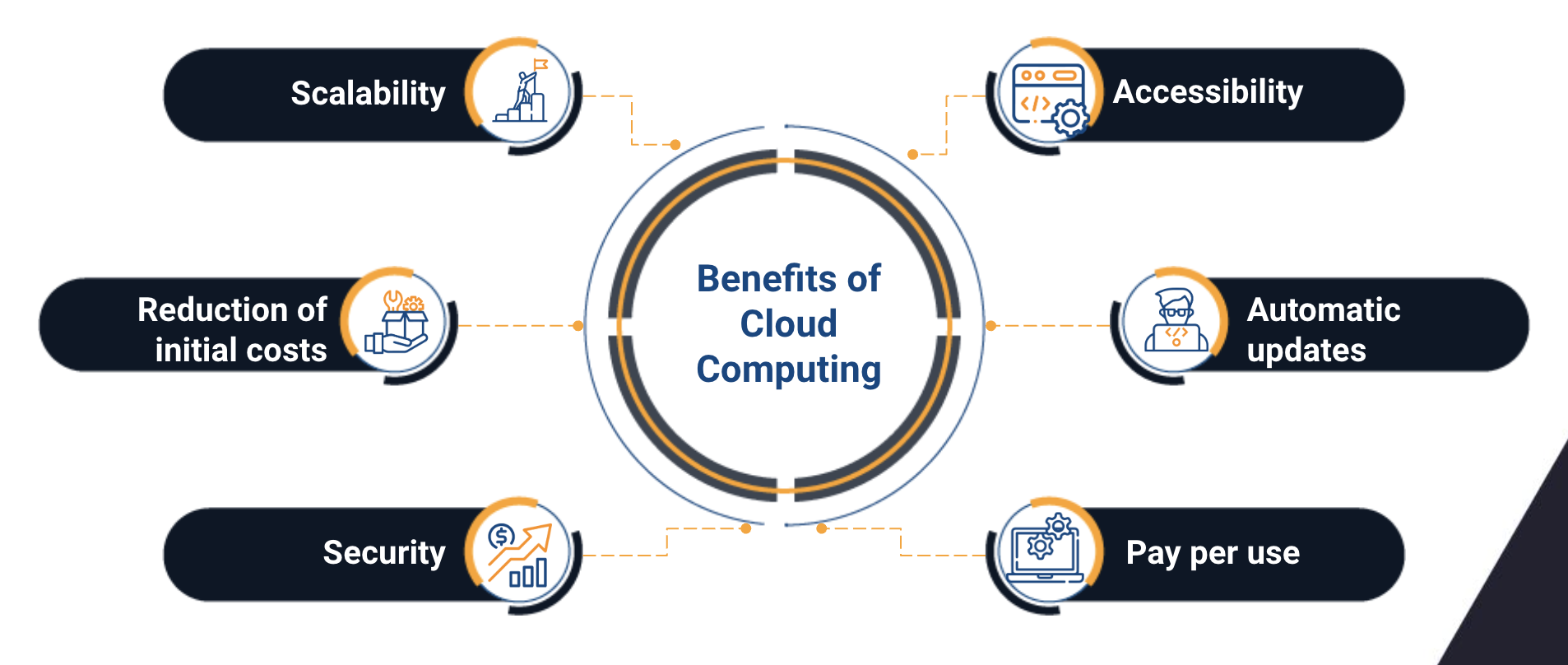
Cost of implementing cloud computing
September 25, 2024
Table of contents
Quick Access

Cloud computing has become an essential pillar for businesses of all sizes, providing flexibility, scalability, and efficiency in managing technological resources. However, one of the key aspects that business leaders must consider is the cost associated with implementing cloud computing services.
Below, we explore in detail what these services are, the benefits they offer, pricing models, and how businesses can manage costs to optimize their cloud investment.
What are cloud computing services?
Cloud computing services allow businesses to access technological resources over the Internet, rather than maintaining their own physical infrastructure. These services include storage, processing, networks, databases, and software, which can be managed and scaled based on business needs. The three most common cloud service models are:
- Infrastructure as a Service (IaaS): Provides access to basic infrastructure, such as virtual servers and storage.
- Platform as a Service (PaaS): Offers a development environment to create, test, and deploy applications.
- Software as a Service (SaaS): Allows businesses to use complete applications, such as CRM systems, without having to install them locally.
Benefits of cloud computing services
Adopting cloud computing brings multiple advantages that boost the competitiveness of companies. Among the most notable benefits are:
Scalability
Cloud services allow resources to be quickly adjusted according to business demands, which is ideal for managing traffic spikes or unexpected growth.
Reduction of initial costs
By not requiring significant investments in hardware or own infrastructure, companies can reduce their initial expenses and move to a pay-per-use model.
Security
Cloud providers typically offer advanced security tools, such as encryption and access controls, protecting organizations' sensitive data.
Accessibility
Employees can access services from anywhere with an Internet connection, facilitating remote work and global collaboration.
Automatic Updates
Providers manage software maintenance and updates, ensuring that businesses are always using the latest versions.

Cloud Computing Service Pricing Models
The cost of cloud services can vary significantly depending on the provider and the pricing model chosen. Generally, the most common pricing models include:
Pay-as-you-go: This is the most flexible model, where businesses pay only for the resources they use. It is ideal for businesses with variable or unpredictable workloads.
Reserve resources: Businesses can choose to reserve compute or storage capacity for the long term (usually one or three years), which gives them discounts compared to the pay-as-you-go model.
Preemptible or interruptible instances: Some providers, such as Google Cloud, offer instances at reduced prices that can be interrupted when the capacity is needed for other tasks. This is a suitable option for workloads that do not require continuous high availability.
Volume discounts: Businesses that consume large volumes of resources often get significant discounts, which incentivizes them to centralize their operations with a single cloud provider.
How much does cloud computing cost for businesses?
The cost of cloud computing for a business depends on several factors, including the size of the organization, processing and storage needs, and the amount of data transferred. Below is a breakdown of the main cost components:
Compute
The number of virtual machine (VM) instances, Kubernetes clusters, and processing resources used are key factors. For example, a server instance with 4 vCPUs and 16 GB of RAM can cost between $54 (Oracle Cloud Infrastructure) and $134 (Microsoft Azure) per month for 744 hours of use.
Storage
Storage needs vary depending on data volume and performance requirements. High-performance storage, such as that used for critical databases, costs more compared to standard storage.
Network
Networking usage, including data transfer between regions or data egress, can add additional costs. For example, some providers charge hefty fees for data egress from their servers to external networks.
Additional Services
Depending on business needs, costs may be added for services such as managed databases, API integration, monitoring tools, and advanced security.

How Businesses Can Manage Cloud Costs
Since cloud costs can escalate quickly if not managed properly, businesses should implement practices to optimize usage and minimize unnecessary expenses. Here are some key tips:
Right-size usage: Businesses should avoid paying for more resources than they actually need. It is essential to choose providers that offer technologies that enable self-management of compute instance size and auto-scaling.
Continuous optimization: Organizations should conduct regular reviews to identify underutilized resources, such as idle instances or storage volumes, that can be eliminated or resized.
Vendor evaluation: When comparing different cloud providers, it is crucial to review all the details, including variable costs, data egress fees, and levels of technical support offered. Additionally, some companies may benefit from opting for providers that include security and availability features within their standard offerings.
Budgeting for implementation and migration
In addition to operational costs, companies must consider the initial expenses associated with cloud migration. These may include:
- Architecture design: Cloud specialists to design and optimize the architecture.
- Development and tuning: Adapting existing applications to run in the cloud.
- Migration management: Services to manage the transfer of data and applications.
- Training: Training staff to use the new cloud infrastructure.

Comparing vendor costs: AWS, GCP, Azure, and OCI
When looking at cloud costs, it's important to compare the top vendors. Here's a rundown of estimated pricing for a virtual instance with 4 vCPUs and 16 GB of memory running 744 hours per month:
- Amazon Web Services (AWS): Starting at $100 per month.
- Google Cloud Platform (GCP): Around $99 per month.
- Microsoft Azure: Around $134 per month.
- Oracle Cloud Infrastructure (OCI): $54 per month, with advanced security and high-performance options.
Deploying cloud computing services can offer huge benefits in terms of efficiency and scalability, but it also requires careful planning to manage costs effectively. By understanding pricing models and cost components, businesses can maximize the value of their cloud investment while avoiding unnecessary expenses.
We recommend you this video
Related Blogs
How to use automation in your email marketing strategy
.jpg)
How much time does marketing automation save?
.jpg)
How to implement marketing automation in a simple way
.jpg)
Vertical vs Horizontal Scaling: Side-by-Side Analysis for Developers
.jpg)
Svelte vs React: Pros, Cons, and Use Cases

